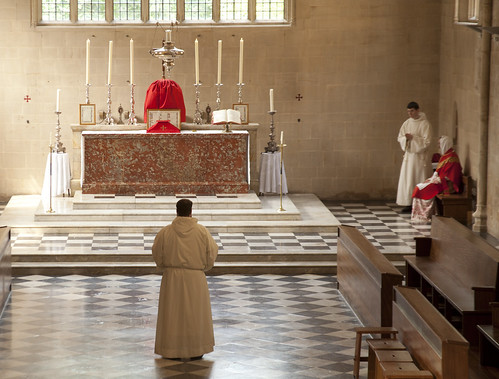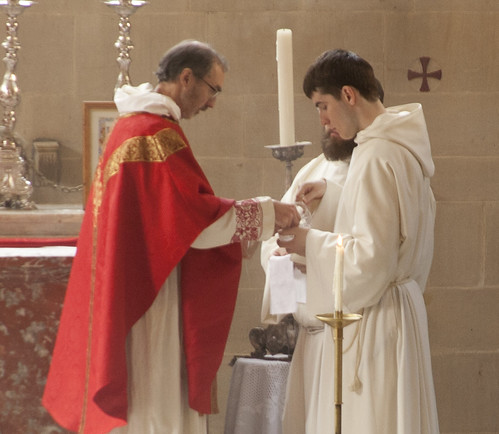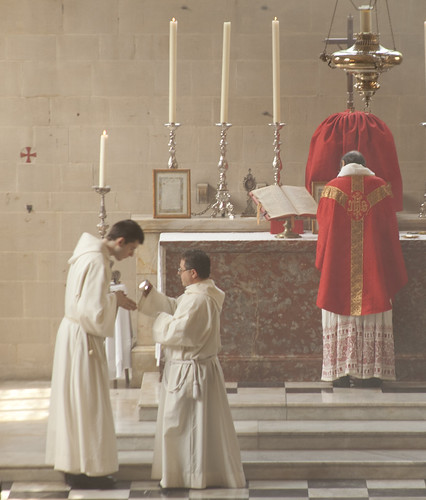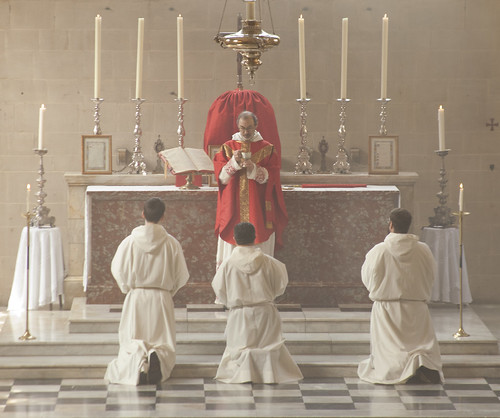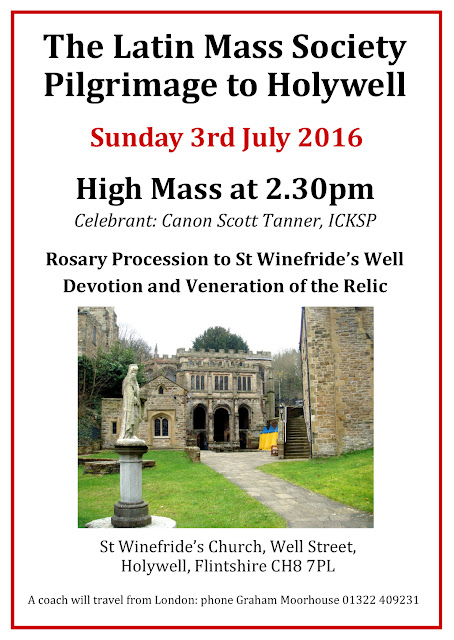Chairman's Blog
Dominican Missa Cantata for Bl Margaret Pole: photos
A gesture characteristic of the Dominican Rite, and not found in the Roman Rite: just after the Consecration.
Mass last Saturday was for Bl Margaret Pole, Countess of Salisbury, executed by Henry VIII out of hatred for the Catholic Faith on 28th (or 27th) May 1541. She was the daughter of George, Duke of Clarence - the one done to death in butt of wine in Shakespeare's Richard III (and, extraordinarily, probably in real life as well). Henry VII married her off to a loyal relation of his, Richard Pole, and she became lady in waiting to Catherine of Aragon, both during Catherine's engagement to Prince Arthur, who died, and when she was married to Henry VIII. Margaret's son Reginald Pole, in holy orders on the continent, wrote against the break with Rome, and two of her other sons were executed for treason (ie, Catholic sympathies).
As a Plantagenant, a Catholic, an associate of Queen Catherine, and the mother of Cardinal Pole, Henry VIII had no shortage of reasons to hate her. Nevertheless she remained in the Tower for two years before the king ordered a hasty and almost botched beheading, when she was 67.
This was the first Dominican Missa Cantata I have attended. The Epistle was sung by a cleric.
Another characteristic of the Dominican Rite: the use of the Paxbrede at the kiss of peace, for clergy, servers, and religious in choir. In the Roman Rite the Pax is normally given by the 'emplexus', embrace, but this only happens at Solemn Mass. The Roman Rite does use the Paxbrede for Prelates sitting in choir in Low Mass, and interesting the Pax is extended to the congregation using the Paxbrede in Spain and its former possessions, as was the practice in England in the Middle Ages.
Support the work of the LMS by becoming an 'Anniversary Supporter'.
Worship towards the East: video
Cardinal Robert Sarah has reopened the debate on the best 'direction' for worship, favouring the direction of 'liturgical east', the same direction as the Faithful in the nave, over 'versus populum', facing the people over the Altar like an executive facing his underlinings over a desk.
He said in an interview: “But as soon as we reach the moment when one addresses God – from the Offertory onwards – it is essential that the priest and faithful look together towards the east. This corresponds exactly to what the Council Fathers wanted.”
In honour of this occasion I repost a video recorded in 2014. To learn more on the theology and history of the debate, see the FIUV Position Paper here.
Support the work of the LMS by becoming an 'Anniversary Supporter'.
New book: God of the Gulag by Jonathan Luxmoore
 Any book shining a light on the heroic witness of those killed for their Christian faith under Communism is to be welcomed. This major two-volume work is especially so, because of its comprehensive coverage of Soviet and Soviet-bloc persecution.
Any book shining a light on the heroic witness of those killed for their Christian faith under Communism is to be welcomed. This major two-volume work is especially so, because of its comprehensive coverage of Soviet and Soviet-bloc persecution.
Well done to Jonathan Luxmoore, otherwise known for his occasional news stories in the Catholic press. The publication of this work marks the culmination of a massive project of research and writing.
The book is available from Amazon (Vol 1, Vol 2) and directly from Gracewing.
----------------------------------
God of the Gulag, by Jonathan Luxmoore
Volume 1: Martyrs in an Age of Revolution
The eight decades from the Bolshevik Revolution to the collapse of the Iron Curtain brought a wave of anti-religious repression comparable to anything seen in the fabled persecutions of the first Christian centuries. It inflicted sufferings and agonies equalling those of the darkest periods; and it stimulated writings and reflections paralleling the most insightful and moving from Christian history. This first volume of The God of the Gulag shows how the paradigms of persecution and martyrdom were established in the Early Church, when Christians were hounded by the Roman state as a threat to the established order-and how they reappeared when anti-Christian persecution returned on a mass scale after the French Revolution, as new hostile states and popular movements tried again to dismantle the power and influence of the Christian Church. Drawing on accounts and documents in many languages, it examines the first phase of communist rule after the 1917 Russian revolution, when a ruthless campaign was launched to destroy all organised religion and redirect spiritual strivings towards an absolute subservience to the Marxist vision. It looks at how Christians attempted to defend the Church and witness to their faith as the communist dictatorship was extended under Stalin to post-War Eastern Europe, bringing a new wave of arrests, trials and purges.
9780852446393 - 536 pages £20.00

Volume 2: Martyrs in an Age of Secularism
By the end of the 1950s, more than four decades had passed since Lenin and his Bolshevik followers had first seized power in Russia. Open brutality and terror had given way to administrative forms of repression and control. But the aim of communism was still very much alive-to create an egalitarian society ruled by the working class under the direction of the Party avant-garde. Intimidation and coercion by the secret police were still indispensable tools for pursuing that aim. Hostility to the Church and contempt for religious faith were still fundamental to the communist programme. This second volume of The God of the Gulag details the continuing campaign against the Church and its members, as the age of revolution gave way to an age of secularism, and new efforts were made to impose scientific atheism and rid the world of religious superstition. Drawing on accounts and documents in many languages, it shows how the requirements of Christian witness evolved as the policies and tactics of the one-party state developed, and how Church leaders sought new ways of sustaining religious life after the 1962-5 Second Vatican Council. It recounts how growing dissent was strengthened by the shock-election of a Polish Pope in 1978 and the rise of the Solidarity movement two years later, and how the bitter and protracted endgame of communist rule was played out in the 1980s. It assesses the lessons to be learned by the Church and its opponents from this modern era of persecution and martyrdom; and it looks at how the heroic testimony of the twentieth-century martyrs should be recognised and commemorated.
9780852445846 - 484 pages £20.00
Support the work of the LMS by becoming an 'Anniversary Supporter'.
Video of Cardinal Burke celebrating Low Mass in Oxford
I posted a number of photos here; I have finally posted up a short video, including snatches of the very lovely music sung on this occasion.
Support the work of the LMS by becoming an 'Anniversary Supporter'.
Would you like to edit Mass of Ages?
The Latin Mass Society was incredibly lucky to secure Dylan Parry, long-standing editor of
Westminster Cathedral's magazine Oremus, to edite Mass of Ages. Now Dylan, for positive rather than negative reasons, is moving on, and we need a new editor to carry on his work.
Vacancy for a Managing Editor, Mass of Ages
Support the work of the LMS by becoming an 'Anniversary Supporter'.
What sort of Mass did 'Vatican II' want?
| The Traditional Mass on the Chatres Pilgrimage. Not as off-putting to young people as Pope Paul VI imagined. Photo by John Aron. |
Liturgical conservatives and progressives argue endlessly about this. Their argument will never be resolved, both because Sacrosanctum Concilium was and the subsequent magisterium has been self-contradictory, but also because neither side in the debate is willing to be honest about the historical facts. I am sorry to be harsh, but having read the output of both sides of the debate over a number of years, it is time it was said.
First, Sacrosantum Concilium: how is it self-contradictory? It makes few concrete suggestions, but it does make some. It calls for wider use of the vernacular (63); the removal of 'useless repetition' (34), and a more 'lavish' presentation of the Scriptures in the readings, arranged 'prescribed number of years' (51). It leaves further details to local initiative and an official commission. On the other hand, it says (23)
there must be no innovations unless the good of the Church genuinely and certainly requires them; and care must be taken that any new forms adopted should in some way grow organically from forms already existing.
It is perfectly obvious that the this double condition is not satisfied by the concrete suggestions the document itself makes. There is no precedent in the liturgical tradition of the Church, in any Rite, for a multi-year lectionary, and to suggest that such a thing could grow 'organically' out of a single-year lectionary is obviously absurd. There is no precedent for a mixing of Latin and the vernacular in the liturgy, or for the liturgy to be translated into dozens of vernaculars for different countries. The principle militating against 'useless repetition' is entirely foreign to the Church's liturgical tradition. And none of these changes could possibly, in advance, be said to be required 'genuinely and certainly' by the good of the Church.
From this fundamental self-contradiction, you can draw any conclusion you like. Perhaps the 'general principle' of section 23 should control our interpretation of the specific examples of reforms; perhaps it is the other other way around. The fact is, there is no coherent programme of reform in Sacrosanctum Concilium. Let's not engage in make-believe. It is a compromise document with provisions pointing in different directions.
It was, however, interpreted by those appointed to interpret it, and the Novus Ordo Missae was signed off by Pope Paul VI. So what liturgical style are we guided towards by the official documents, documents of the 'living magisterium' as the conservatives like to call them, which accompanied and followed the promulgation of the new missal?
Well, these documents too are mutually contradictory. The architect of the reforms, Archbishop Annibale Bugnini, made a great deal of the provision of Sacrosanctum Conciium 34:
The rites should be distinguished by a noble simplicity; they should be short, clear, and unencumbered by useless repetitions; they should be within the people's powers of comprehension, and normally should not require much explanation.
This is his justification for rewriting practically every Latin prayer in the Missal, and then authorising its translation into kindergarten English: projects which were, of course, officially approved and given authoritative promulgation by the Church's Supreme Legislator, the Pope. Where does the 2011 'new translation' come from? It comes from a much later document, the 2001 Instruction Liturgiam authenticam which states (27):
|
If indeed, in the liturgical texts, words or expressions are sometimes employed which differ somewhat from usual and everyday speech, it is often enough by virtue of this very fact that the texts become truly memorable and capable of expressing heavenly realities.
|
The fact has to be faced: in proposing a 'hieratic', 'sacred' liturgical register, it introduces a liturgical principle for the guidance of translators which simply is not to be found in Sacrosanctum Concilium or in the numerous documents of the 1970s and 1980s, documents like the toe-curling Directory for Masses with Children in 1973. There had been a massive conservative push-back in the 1990s and Liturgicam authenticam was the result. So patent was the contradiction between the two eras that Liturgicam authenticaum actually abrogated a whole raft of official guidance from before 1994:
|
8. The norms set forth in this Instruction are to be substituted for all norms previously published on the matter,
|
We need to face the fact: the magisterium's own interpretation of Sacrosanctum Concilium is a moving target. It was quite different in the 1970s than it was by the mid 1990s. Who knows where it will be in ten years?
Let me give a couple more examples: on the use of Latin and on Gregorian Chant.
Latin: for. Sacroscantum Concilium
36. 1. Particular law remaining in force, the use of the Latin language is to be preserved in the Latin rites.
101. 1. In accordance with the centuries-old tradition of the Latin rite, the Latin language is to be retained by clerics in the divine office.
Pope John Paul II: Dominicae Cenae (1980) 10:
[Latin is] an expression of the unity of the Church and through its dignified character [it] elicited a profound sense of the Eucharistic Mystery. ...The Roman Church has special obligations towards Latin, the splendid language of ancient Rome, and she must manifest them whenever the occasion presents itself.
Instruction Ratio fundamentalis institutionis sacerdotalis (1980):
the Council is far from having banned the use of the Latin language. Indeed, it did the contrary. Thus the systematic exclusion of Latin is an abuse no less to be condemned than the systematic desire of some people to use it exclusively. Its sudden and total disappearance will not be without serious pastoral consequences.
Latin: against. Pope Paul VI, Nov 26 1969
No longer Latin, but the spoken language will be the principal language of the Mass.
If the divine Latin language kept us apart from the children, from youth, from the world of labor and of affairs, if it were a dark screen, not a clear window, would it be right for us fishers of souls to maintain it as the exclusive language of prayer and religious intercourse?
Dozens of official references to the allegedly beneficial effect of putting the liturgy in the vernacular, as something done by the Council, could be cited.
Chant: for. Sacrosanctum Concilium
116. The Church acknowledges Gregorian chant as specially suited to the Roman liturgy: therefore, other things being equal, it should be given pride of place in liturgical services.
Pope Paul VI: Sacrificium laudis 1966 (to religious superiors)
One can also wonder whether men would come in such numbers to your churches in quest of the sacred prayer, if its ancient and native tongue, joined to a chant full of grave beauty, resounded no more within your walls.
Paul VI Voluntati Obsequens 1974
... the liturgical reform does not and indeed cannot deny the past. Rather does it "preserve and foster it with the greatest care." It cultivates and transmits all that is in it of high religious, cultural and artistic worth and especially those elements which can express even externally the unity of believers.
Chant: against. Pope Paul VI, Nov 26 1969:
We will lose a great part of that stupendous and incomparable artistic and spiritual thing, the Gregorian chant.
Instruction Concerts in Churches 1987:
There is a way of reading these documents which minimises the tension, for example by saying that Latin and Chant be used in a few places, but not for 'most' of the Mass: Paul VI mentions the singing of the Creed and the Our Father. But the attitudes underlying these documents make perfectly reasonable the more extensive application pushed by conservatives and progressives, in opposite directions.
If Latin and Chant are powerful and profound, if they exemplify unity and foster vocations, and if the reform was not about breaking with the past but 'fostering' our traditions, why not have Latin propers chanted, and why not have the Canon, or indeed the whole of Mass, in Latin?
On the other hand, if participation requires comprehension without, usually, any explanation, and if the former liturgical practice failed to appreciate this - if it was like a 'dark screen' - then Latin and Chant have no place in the Mass at all.
Those seeking, in Conciliar and post-conciliar documents, guidance on liturgical principles, with a view to the way Mass should be celebrated, and perhaps with a view to future reform, should stop right here. There is no single, coherent, vision of the liturgy in these documents. There is, instead, a debate. In the end, one side of this debate must win, and the other side must lose.
I would like to appeal to the 'reform of the reform' writers, and to the progressives on Pray Tell and elsewhere: stop accusing each other (and traditional Catholics) of contradicting authoritative documents and the 'real' principles of Vatican II. On this subject, arguments from authority will get us nowhere.
The only way to think with the Church on the liturgy is to take a longer view: to look at what the Church has done, not over a few decades, but over millennia. The very idea of doing this, of course, contradicts the claim that everything up to 1965 was bad. But it is that idea, rather than an honest appraisal of the modern liturgical documents considered here, that is really troubling for the doctrine of the indefectability of the Church. If the Church was wrong up to 1965, why pay any attention to what she has said since then?
Support the work of the LMS by becoming an 'Anniversary Supporter'.
The OF and the EF: how they are related
Today I repost this from 2013, partly in response to two things which I saw on social media, from conservative Catholics about the Novus Ordo. Here, Fr Richard Heilman wishes that the Ordinary Form be celerbated like 'the actual Mass of Vatican II'. This turns out to be a reference to the 1965 liturgical books, which may have been celebrated during the latter part of the Council, but certainly isn't what the Council wanted the Mass to be like. Here, John Allen quotes a priest praising the new translation because it faithfully renders the Latin prayers, 'considering the antiquity and universal usage of these prayers'. But very few ancient Latin prayers survived unscathed into the Novus Ordo.
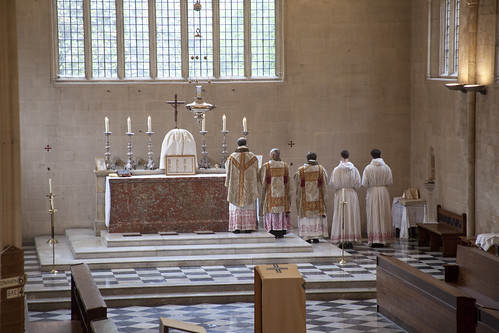 |
| Dominican Rite: lining up side by side, not, as with the Roman Rite, one behind the other. |
I've received a comment on my last post:
'Joseph, for the benefit of readers, could you list some of those features which the Novus Ordo lacks -- "features ... so centrally characteristic of the Roman Rite that anything lacking them has to be categorised as something else"? I'd like to hear the features that strike you as characteristic in such a way that the two forms would be divided by having or lacking them.'
This is a fair question, and I didn't address it the other day only for reasons of space. Here is a nice reply by the liturgical scholar and Latinist Philip Goddard, in a letter in the Catholic Herald from a couple of years ago (29 April 2011):
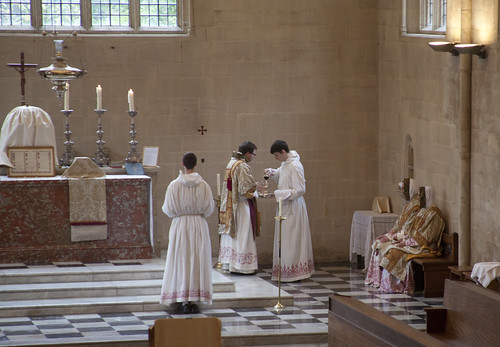 |
| Water and wine added to the Chalice (at High Mass) during the Gradual and Alleluia, not at the Offertory. |
'Although I agree with much of what Fr Leo Chamberlain says (Letter, April 1), especially about the the effects of relativism on religious faith and practice, I do not see how he can seriously maintain that the new Roman rite is in accordance with tradition.
In the Roman tradition Mass is celebrated in Latin: in the New rite it is normally in the vernacular. In the Roman tradition the celebrant faces East: in the New rite he almost always faces versus populum. In the Roman tradition there is a single annual cycle of readings: in the New rite there is a triennial cycle. In the Roman tradition the non-Gospel readings are recited or sung by an ordained minister; in the New rite they are recited by a layman. In the Roman tradition there is a single Eucharistic Prayer; in the New rite there are many. In the Roman tradition Holy Communion is received kneeling, on the tongue, from an ordained minister; in the New rite is it generally revived under both kinds, standing, in the hand, and often from a lay minister. In the Roman tradition the service of the altar is restricted to males; in the New rite it is open to both sexes. One could go on and on listing the differences, if space permitted.
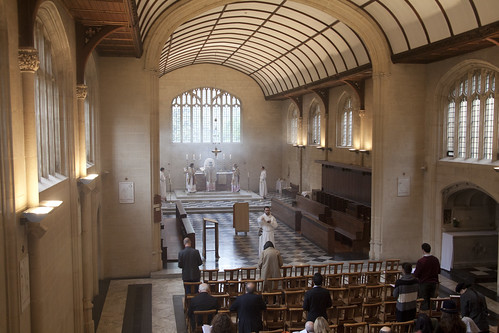 |
| Thurible raised and lowered, not swung. |
No doubt Fr Chamberlain would argue that some, or even all, of these innovations are beneficial. That is as may be. Traditional, however, they are not.'
(There's more about this correspondence with Fr Chamberlain, in which I was also involved, here.)
It is sometimes said that continuity is preserved in part because many of the innovations listed are not obligatory. It is possible to celebrate the Novus Ordo entirely in Latin, with male servers, ordained readers, and the like. But comparing rites is a matter of comparing the body of rubrics, texts, and rules, and common practice, and those rubrics, texts, and rules, and the common practice, are radically different. It is would be absurd to deny that the Mozarabic Rite was a separate Rite because, under some options under some peculiar liturgical circumstances, it can be said in a way quite similar to the Roman Rite under another set of options and peculiar circumstances. It is different because of the differences.
 |
| The Kiss of Peace administered using a 'paxbrede', not an embrace. |
And of course the very fact that there are all these options is another radical break with the tradition of the Roman Rite. The priest can never choose between languages, Eucharistic Prayers, Prefaces, or readings, in the Roman liturgical tradition. This is an extremely important part of that tradition, which is essential to the character of the Traditional Mass as something given to us by the Church, not thought up on the spot by a liturgy committee.
Finally, when saying they are different one should bear in mind the kinds of differences which as a matter of course justify scholars in saying that the Byzantine and the Maronite Rites, or whatever, are different Rites. Obviously they are all rites of Mass. Obviously they all have important features in common - the features common to all rites of Mass, or to many of them. The differences may even seem subtle, if you leave the language of the Mass aside. There are re-arrangements of some elements (when i the Pax takes place, for example); some things are added in one and excluded from another. They are all good and pious rites of Mass, they are just different.
The Novus Ordo, it has often been pointed out, is more different from the 1962 Mass than the latter is from a number of Rites which are nevertheless agreed to separate Rites.
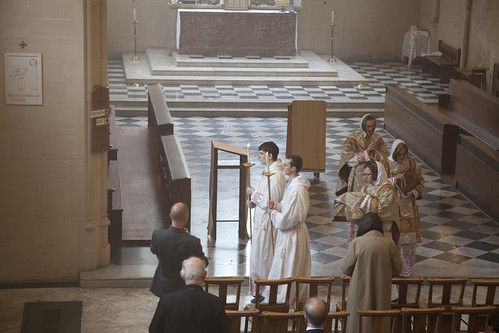 |
| Hoods raised processing in and out. |
I am of course very familiar with the argument in favour of continuity, and the people making it are often doing so for noble reasons. We must remember, however, that the greatest exponent of the 'hermeneutic of continuity', Pope Benedict XVI, was also the man who did more than anyone to make the reality of the liturgical rupture part of the respectable debate. The hermeneutic of continuity is not about denying the fact of change before our eyes; it is about accepting the tradition stretching into the past as a living part of the Church's patrimony, which conditions how we understand the teaching of the Second Vatican Council, and indeed the rest of our experience.
Photos: High Mass in the Dominican Rite. The question of whether the Dominican Rite and the Roman Rite are really separate Rites, or whether the former is a 'Use' of the latter, is debated, on historical grounds: where did the Dominican Rite come from? But these are the kinds of differences which are significant between one Western Rite and another.
Loftus attacks Archbishop Sample: on chant and children
Further to my recent posts about Montessori and children, I'm reposting this from 2014. I've not been keeping up my review of Mgr Basil Loftus output recently, but whenever I look at his columns I see that they make just as much sense as they ever did.
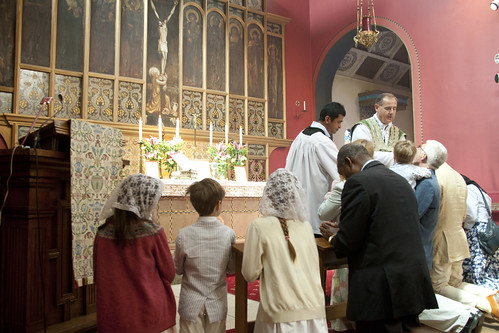 |
| Children at St Mary Magdalen, Wandsworth, a Mass with Chant propers and polyphonic Ordinary. |
Every now and then Mgr Basil Loftus makes reference to singing in Mass. It appears to be one of his many obsessions. A classic was his suggestion that when the General Instruction recommends a chant or song at Communion, this rules out adherence to the Instruction Redemptionis Sacramentum's requirement that the Communion Plate be used, and the recommendation in that instruction, now a requirement of our own Bishops' Conference, that the Faithful make an 'act of reverence' before receiving Communion, because of the difficulty of multi-tasking...
It is not surprising, therefore, that when he turns his attention to chant and hymns he comes out with the usual muddle and deliberately misleading claims.
He starts by quoting Archbishop Sample of Portland, Oregon:
'It is clear that the Council calls for the liturgy to be sung. In recent decades we've adopted the practice of singing songs at Mass. We take the Mass and attach four songs or hymns to it. But this is not the Church's vision. We need to sing the Mass. It is meant to be sung. The texts of the Mass are meant to be sung.'
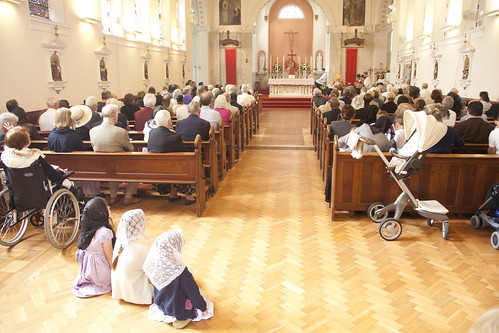 |
| Children at the LMS Pilgrimage to Holywell. |
Loftus' comment on this typifies his disregard for making sense, as well as good manners or respect for his superiors:
The archbishop's observation, while very helpful, is also both simplistic and deceptive.
Was it a subeditor who added the phrase 'very helpful'? Or is Loftus able to hold two incompatible judgments in his head at the same time?
His reason for saying that Archbishop Sample is being 'simplistic and deceptive' is that he cannot get his mind around the very simple point that the Archbishop is making: that when hymns are sung, in the Novus Ordo, they are sung instead of the singing of a liturgical text. The General Instruction says: you can sing the Introit chant, or something else. Later on, you can sing the Offertory chant, or something else. At Communion, you can sing the Communion chant, or something else. If, each time, you find yourself singing a hymn, you are doing so at the expense of singing the chant texts set for the day.
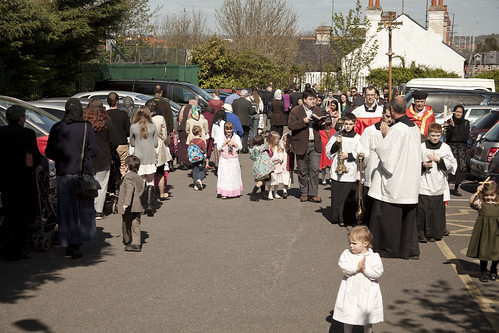 |
| Ok, so she's not in exactly the right place, but she's doing her best... Palm Sunday with the FSSP in Reading. |
Of course, the wider legal and textual situation in the Novus Ordo is a nightmare of confusion and mixed signals, which I have addressed, a little, here. Nevertheless, Archbishop Sample is right that by replacing the chants with hymns, we are moving from a liturgical text - an ancient, Catholic, liturgical text, in fact - to something which is at best para-liturgical, and often not even Catholic.
Loftus' argument against the use of the liturgical texts is the typically patronising argument that chant is not appropriate for ordinary people in ordinary Masses.
The aura, ethos and culture of a monastic Mass cannot easily by transplanted in a parish Sunday Mass. Nor is it always appropriate to try to do so. Not many abbots presiding at conventual Mass in their monasteries have the ethereal, numinous and meditative qualities of their organ-led Greogorian-chant shattered by a four-year-old returning from the children's liturgy and informing him: "I want to wee."
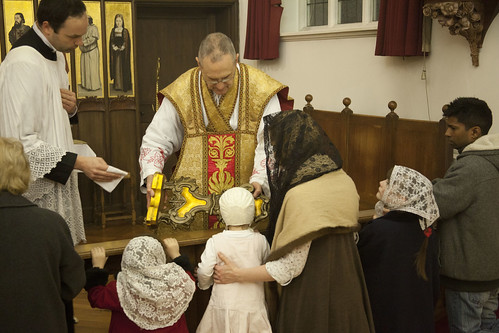 |
| Venerating a relic of St Gregory the Great, the codifier of the Chant repertoire, at SS Gregory & Augustine in Oxford. |
Has Loftus ever actually seen a Mass with chant being sung with a congregation with lots of small children? Anyone tempted by his line of argument urgently needs to get themselves to the regular, sung Traditional Mass celebrated in places such as Reading, by the Fraternity of St Peter, St Bede's, Clapham Park, or Blackfen. I have taken my children, who range from six months to ten years of age, to such Masses all their lives, and I have myself sung, yes sung chant, at the great majority of those Masses, in a large number of locations with fellow worshipers from every corner of the land and every walk of life, so unlike Basil I know exactly what I am talking about. The reality is that children respond to the atmosphere created by chant at least as much, and I would say actually more, than adults.
The atmosphere created by chant is at least in part a matter of association: that is to say, it is learnt. To compare like with like, therefore - adults and children equally unfamiliar with chant - then small children are at a huge advantage, because they learn fast, they have no preconceptions, and they are imitative. They want to do what other people are doing.
When the association is embedded, in children and adults, again if we are comparing like with like, then children again have a big advantage, because - as anyone who knows children knows - children are conservative. Once a habit is established, the way the Christmas tree is decorated or the table is laid, children naturally stick fast to it. Once they've learnt that chant accompanies an activity for which they need to be quiet, they will be very resistant to anything contradicting this principle.
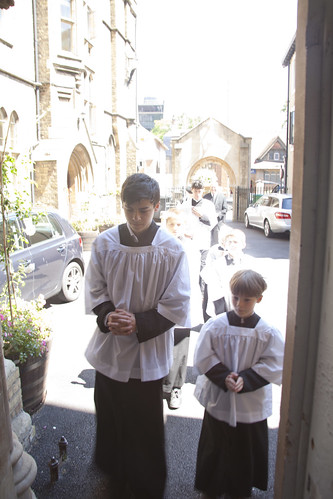 |
| Servers at a funeral in the Oxford Oratory. |
I suppose Loftus may have in mind an unfair comparison, between adults who have a dim recollection of chant as associated with the sacred, coupled with a vague sense of duty about how to behave in church, and children whose liturgical instincts have been un-formed as a result of infrequent visits to church, and mis-formed by hyper-active 'kiddies hymns' and 'children's liturgies'. If children behave inappropriately for those reasons, however, it is the grown-ups who are to blame.
What the four-year-old of Loftus' fantasy needs, then, after his visit to the loo, is an end to the 'children's liturgy', and consistent exposure to chant, ideally at the Traditional Mass. If he observes other people lower their voices in church, with a little encouragement he will do the same. Small boys can be more prone to restlessness in church than girls, but wait a couple more years and he'll be joining the serving team, and your problems are over.
Obviously, this is not going to happen if there are girls serving. But that's just reason number 94 for making sure it is the Traditional Mass.
There are many other errors in the article, but as usual I can't address them all. For example, the Gloria is not a hymn in any usefully descriptive sense: it is not metrical. Like the Psalms, it can be sung using Gregorian Chant because this can cope with texts which don't have strict dum-di-dum rythms and lines of equal length. (It is called a 'prose'.) Metrical hymns have a very long history in the Roman liturgy, in the Office, but never - never - in Mass, until vernacular hymns crept in as a result of Protestant influence.
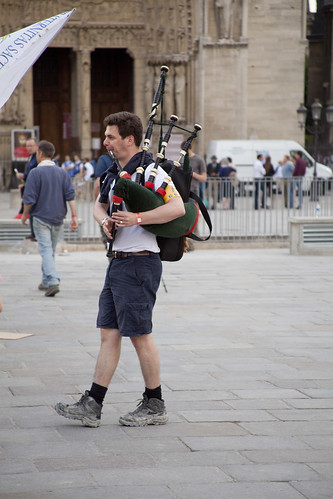 Noting that the Vatican II document on the liturgy, Sacrosanctum Concilium, allows a range of musical instruments to be used in the liturgy, Loftus writes:
Noting that the Vatican II document on the liturgy, Sacrosanctum Concilium, allows a range of musical instruments to be used in the liturgy, Loftus writes:
If the bagpipes is the chosen instrument, then the type of music must be tailored to it. This may exclude Gregorian chant.
A bizarre attempt to put the cart before the horse: to claim the right to choose the instrument and then fit the music to it, regardless of liturgical considerations. However, it is not a well chosen example. I learned on the Chartres Pilgrimage that it is perfectly possible - strange, perhaps, but perfectly possible - to play chant melodies on the bagpipes, from the chap in the picture.
As a service to the public, I have put together quotations on a range of themes from Loftus' published writings, mostly his Catholic Times columns, in a dossier here, and made one of his most theologically egregious articles, on the Resurrection of Our Lord, available here.
Support the work of the LMS by becoming an 'Anniversary Supporter'.
About blogging on this blog
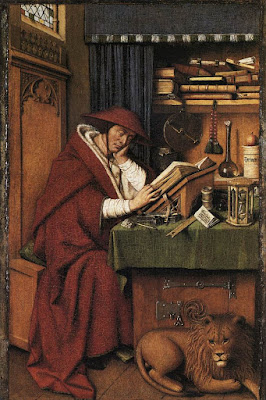 |
| St Jerome in his study. |
I need to free up some time for an academic project, so I am going to take a bit of a step back from this blog for a few months. The most-read posts - such as the ones over the last few days on Montessori and clericalism - are very time-consuming to write. I don't regret using my time in this way, as it has proved very valuable to me in developing my thinking, with the aid of reactions and comments, but I need to take a break from that for a few months.
I'll continue to post announcements and some topical material. What I propose to do to replace the posts I've been doing on liturgical and theological issues - which are the ones, as I say, which generate a relatively big readership - is selectively to re-post material already published on this blog. I hope that doesn't seem like cheating! If so, I apologise in advance.
I will fairly soon be able to post on a brand new Position Paper, however, on the Extraordinary Form and the Laity.
Support the work of the LMS by becoming an 'Anniversary Supporter'.
LMS Pilgrimage to Holywell: Sunday 3rd July
Come and visit the only shrine in England and Wales which survived the destruction of the Protestant Revolt: the beautiful healing well of St Winefride in North Wales.
It's not as difficult to get there as you might think! From the south, north, and East there are motorways which take you to Chester, and an excellent main road takes you the rest of the way. Click for a map. There is even a coach from London- see the poster.
Note that unusually among LMS pilgrimages, this event is (as always) on a Sunday. The celebrant is the young English priest of the Institute of Christ the King Sovereign Priest, Fr Scot Tanner.
As well as High Mass there is a procession to the well and veneration of St Winefride's relic.
Support the work of the LMS by becoming an 'Anniversary Supporter'.


